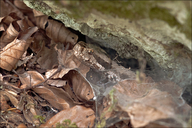date of photo Aug 22, 2015
latitude 46.36010 longitude 13.70273
View on Google Maps.
location
Lower Trenta valley, between villages Soča and Trenta, right bank of river Soča, south of 'Na melu' place near cottage Trenta 2b, East Julian Alps (Posočje, Slovenia)notes Slo.: hibrid med modrasom in navadnim gadom --- Note: This is not Vipera ammodytes but a hybrid, which name seems impossible to be used at CalPhotos - Vipera ammodytes x Vipera berus! --- Habitat: Former pasture (abandoned about 50 years ago), now overgrown with light, mixed forest with sparse ground vegetation, Picea abies dominant (mostly deteriorated by fungus Heterobasidion annosum), followed by Fagus sylvatica and Ostrya carpinifolia, Fraxinus ornus; south oriented, slightly inclined, relatively warm and dry place; ~50 m above Soča river bed and ~250 m away of it; colluvial, skeletal, calcareous, shallow-soil ground with many large boulders scattered around; mostly in shade; average precipitations ~ 3.000 mm/year, average temperature 7 -9 deg C, elevation 590 m (2.000 feet), alpine phytogeographical region. - Comments: When I noticed this snake I looked strange. From its narrow, vertical iris in eyes and more or less triangular head I knew only it was poisonous. Only three (seriously) poisonous snakes live in Slovenia, all of them belong to genus Vipera; most frequent and most poisonous is nose-horned viper (Vipera ammodytes), follow Adder (Vipera berus) and European asp (Vipera aspis). The find fit to none of them. The snake was similar to Vipera ammodytes, but it lacked characteristic and conspitious 'horn' on its nose. Later, by comparing the pictures with my (few) zoological books, I thought it was Vipera ursinii macrops. If my determination were correct, this would be a first class find. Namely, this snake lives west of us and in different habitat. But I was wrong. Herpetologists at Societas Herpetologica Slovenica (Ref.: 2) in Ljubljana tentatively determined the snake to be either a malformed, mutated Vipera ammodytes or one of two possible hybrids Vipera ammodytes x Vipera berus or Vipera ammodytes x Vipera aspis. The pictures were send to the Department of Environmental Sciences, Section of Conservation Biology, University of Basel (Ref.:1) where herpetologist Konrad Mebert tentatively determined it as a hybrid Vipera ammodytes x Vipera berus. - Such hybrids are very rare. Several single specimens from a few countries (Bulgaria, Romania, Switzerland and Italy) have been reported and described during last and this century. But, distinction between mutants and hybrids is not a simple task. Until about two decades ago several herpetologists even doubted in existence of such hybrids (Ref.:4). Later, intermediate external traits have been shown to be a reliable indicator of admixed ancestry (Ref.8). Nevertheless, 100% certainty can be guaranteed only by comparison of DNA of the find with the DNA of supposed parents. - Apparently this find is the third or fourth from Slovenia. A hundred years ago (in 1914) a two specimens of this hybrid were reported (Ref.:5) and a preserved head of a viper exists in Herpetological Collection of the Natural History Museum of Trieste, Italy which, as a result of its corresponding intermediate morphological traits, probably also represents a hybrid between Vipera ammodytes and Vipera berus (Ref.3). The snake was found in Posočje, 9 km north of Bovec, which is not far from this find. May be that further study of it will help to validate the find in the herpetological collection in Trieste? - Many thanks to Mr. Griša Planinc for the literature send to me and for his contacts with Mr. Konrad Mebert. - Ref.: (1) Id'ed by Konrad Mebert, Department of Environmental Sciences, Section of Conservation Biology, University of Basel, Switzerland. (2) Personal communication with Griša Planinc, Societas Herpetologica Slovenica, Ljubljana, Slovenia. (3) K. Mebert, T. Jagar, R. Grželj, V. Cafuta, L. Luiselli, E. Ostanek, P. Golay, S. Dubey, J. Golay and S. Ursenbacher, The dynamics of coexistence: habitat sharing versus segregation patterns among three sympatric montane vipers, Biological Journal of the Linnean Society, June (2015). (4) Schweiger M. 2009. Vipera ammodytes: Von abnormen Vipern und Hybriden, Draco (2009), Vol.39, pp 22–30. (5) G. Sajovic, Beiträge zur reptilienkunde krains, Verhandlungen der Zoologisch-Botanischen Gesellschaft inVienna (1914), Vol. 64, pp 150–175 (Cited after Ref.:3). (6) V. Prpić, Poskok, second ed. (in Croatian), Matica Hrvatska, Zagreb (2009), p 67. (7) Fauna Europas, Bestimmungs lexikon, George Westermann Velag, Braunschweig (1997) (translated to Slovenian), Mladinska Knjiga, Ljubljana (1981), p 255. (8) K. Mebert, K. 2008. Good species despite massive hybridization: genetic research on the contact zone between the water snakes Nerodia sipedon and N. fasciata in the Carolinas, USA. Molecular Ecology (2008), Vol. 17, pp 1918–1929.keywords: snake hybrid
camera Nikon D700/Nikkor Micro 105mm/f2.8
contributor's ID # Bot_907/2015_DSC8424 photo category: Animal - Reptile
|
